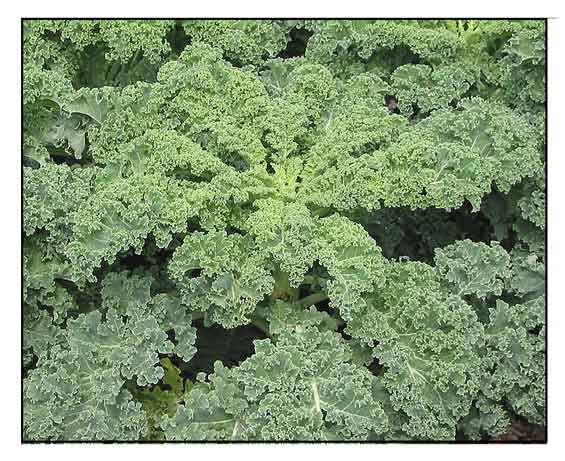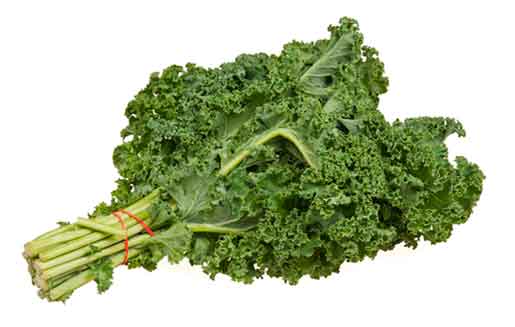 Gen info Gen info
- Brassica oleracea is the main vegetable species of the mustard family Brassicaceae that includes kale, cabbage, brocolli, Brussels sprouts, and cauliflower. (9)
-
Kale or leaf cabbage is one of the cultivars of cabbage (Brassica oleracea) frown for their edible leaves. Kales are considered closer to wild cabbage than most of the other domesticated forms of Brassica oleracea. (1)
- While there are different types of kale, they cook and taste differently: (1) Curly kale: it is the most common variety, and as the name suggests, it is curly and wavy on the leaf edges. A bit tough compared to other varieties, eating it raw benefits from a mild massaging of salt, vinegar, or lemon juice. (2) Tuscan kale: thinner and more tender than curly kale, and required minimum cooking. (3) Red kale: also called "scarlet kale" or "Russian kale." It is identical to curly kale. (4) Baby kale: a younger version of kale. It has a milder flavor, and often used as supplement to other salad greens. (15)
- Classification according to leaf type: (1) Curly leaf (Scots kale, blue curled kale). (2) Bumpy leaf (black cabbage, cavolo nero, Tuscan cabbage). (3) Plain leaf: (Flat-leaf types like red Russian and while Russian kale). (4) Leaf and spear, or feathery-type leaf (cross between 1 and 3). (5) Ornamental (less palatable with tougher leaves). (1)
Botany
Brassica oleracea is a biennial/perennial growing to a height of 0.9 meter. Leaves are elongated, wavy to rosette, green or purple, and, unlike cabbage, the central leaves do not form a head. Flowers are flour-petaled, borne in loose clusters, appearing in the second year. Fruits are dry capsules (siliques).
Distribution
- Cultivated
 Constituents Constituents
- Leave yielded phenolics, polyphenols, glucosinolate, sugars, flavonoid, and flavonoid glycoside.
- Proximate analysis of B. oleracea leaves on a dry weight basis yielded: moisture 9.08 ± 0.06 g/100g, ash 4.34 ± 0.7 g/100g, fat 1.62 ± 0.3 g/100g, crude fiber 7.8 ± 0.42 g/100g, protein 5.12 ± 0.43 g/100g, carbohydrate 72.04 ± 0.56 g/100g, energy 304.88 ± 0.6 kcal/100g, iron 13.5 ± 0.4 mg/100g, calcium 123.40 ± 0.4 mg/100g, vitamin C 24.5 ± 0.4 mg/100g. (3)
- Proximate and mineral composition showed kale to be a good source of vegetable protein (11.67%) and fiber (3.0%). Other proximate parameters were: moisture (81.38%),
ash (1.33%), fat ((0.26%), carbohydrate (2.36%), and energy (58.46 kcal/100g). Mineral contents yielded: sodium (4.69 mg/100g), potassium (7.03 mg/100g), calcium (4.05 mg/100g), iron (8.94 mg/100g), zinc (2.16 mg/100g), and magnesium (6.69 mg/100g). (4)
- Among the top 100 health foods (WHF) and the 5,350 food in the USDA's National Nutrient Database that contains the carotenoid nutrient, kale tops the list in lutein content. (12)
- Nutrient analysis of kale (cooked, 1 cup/130 gm / 36 calories) yields vitamin K 1180% DV, vitamin A 98%, vitamin C 71%, manganese 23%, copper 22%, vitamin B6 11%, calcium 9%, fiber 9%, iron 7%, vitamin E %, vitamin B2 %, magnesium 6%, vitamin B1%, potassium 6%, phosphorus 5%, protein 5%, omega-3 fats 5%, folate 4%, vitamin B3%. (12)
- Glucosinates identified in kale and their derived isothiocyanates are: glucobrassicin
(indole-3-carbinol*), glucoraphanin (sulforaaphane), gluconasturtiian (phenyl-isothiocyanate), glucopaeolin (benzyl-isothiocyanate), sinigrin (allyl-isothiocyanate). Indole-3-carbinol is an not an isothiocyanate but a benzopyrrole, formed when isothiocyanates from glucobrassicin are further broken down into non-sulfur containing compounds. (12)
- Concern: A cupped of chopped, raw kale (16 g) contains 79 mg of potassium; or 491 mg from 100 g (3.5oz). The high potassium content should be a concern for people with kidney problems or patients taking potassium-sparing diuretics.
Properties
- Considered one of the most nutrient-dense foods.
-
Studies have suggested antioxidant, anti-melanoma, anti-inflammatory, phytoremediative properties.
Parts used
Leaves.
Uses
Edibility / Culinary
- Leaves are edible, raw or cooked.
- Young flowering shoots are edible, raw or cooked.
- Used as ingredient in soups and salads.
- Flavor similar to cabbage or sprouting broccoli. (7)
- Prepared as kale juice or smoothie drink.
Folkloric
- No reported folkloric medicinal use in the Philippines.
Studies
• Antioxidant / Leaves: Study of B. oleracea leaves for antioxidant potential yielded: total phenols 35.64 ± 0.56 mg GAE/g, total flavonoids 13.98 ± 0.23 mg QE/g. DPPH free radical scavenging assay yielded an IC50 of 26 µg/ml. (see constituents above) (3)
• Glucosinolate: Kale is an important source of phytochemicals such as glucosinolates that trigger cancer-preventive activity. Study showed the nutritional value varies among glucosinolates and among cultivars (25 kale varieties and 11 non-kale Brassica oleracea cultivars). Results showed glucosinolate levels differ markedly among varieties of different origin. Landraces do not show outstanding glucosinolate levels. Results suggest diversity of kale and important of broad genepool for future breeding purposes. (5) (see constituents above: 12) (also read: 9)
• Effect on Cultured Melanoma Cells / Anticancer: Study hypothesized that the natural context of kale's bioactive compounds may provide significant anti-cancer effects. To test the hypothesis, kale juice was prepared and added to melanoma, epithelial, and fibroblast cells. Serial dilutions were tested on B16F10 melanoma cells to determine the optimum dosage for inducing cell death, There was dose-dependent decrease in cell growth. Sonicated and filter-sterilized extract also significantly reduced growth, but showed different effects on melanoma and epithelial cells. The juice was non toxic ti epithelial cells and fibroblasts at dosages that kills melanoma cells. (8)
• Enhanced Functional Lipids in Controlled Environment Production: Study evaluated the effects of three naturak growth media amendments (potassium humate, dry vermicast, volcanic minerals or Promix) in enhancing the accumulation of functional lipids om greenhouse grown kale). Results showed volcanic minerals and dry vermicast were mist successful in enhancing the accumulation of lipids in kale under controlled environment condition. (10)
• Phytoremediation / Lead: Study evaluated the potential if kale as option fir phytoremediation in areas with high levels of cadmium (Cd) and lead (Pb) pollution. Results showed kale plant can be recommended for phytoremediation of saline soils with 10 and 16 mg/kg Pb and Cd contents, respectively. (11)
• Anti-Inflammatory / Antioxidant / Leaves: Study evaluated the effect of curly kale extracts on cytokine induced expression of endothelial cell adhesion molecules as well as adhesion of leukocytes to endothelial cells depending of polyphenol content and composition. A methanolic extract showed highest antioxidant activity, polyphenolic content, and flavonol concentrations compared to aqueous water extract. The ME and AE reduced cell adhesion of leukocytes to HUVECs and significantly reduced TNF-a induced expression of cell adhesion molecules. The inhibitory effect of water and methanolic soluble ingredients of curly kale leaves in cell-cell interaction and gene expression suggests health promoting effects in inflammatory conditions. (13)
• Composition and Antioxidant Activity / Effect of Cooking: Study evaluated the chemical composition and antioxidant activity of a kale variety and the effect of cooking process on selected characteristics. The investigated kale showed high average contents of ß-carotene (6.40 mg/100 f.m.), vitamin C (62.27 mg/100 g), alimentary fiver (8.39 g/q00g) and ash (2.11 g/100 g f.m.). Polyphenolic content yielded average level of 574.9 mg of chlorogenic acid/100 g f.m. Antioxidant activity by ABTS radical scavenging assay was 33.22 µM Trolox/g fresh vegetable. Cooking results in a significant lowering of antioxidant compounds with vitamin C loss of 89%, polyphenols at 56%. Beta-carotene showed highest stability with loss of only about 5%. Antioxidant activity lowered to 38%. Mineral losses were 13% for zinc and 47% for sodium. Results suggest the vegetable should be eaten in raw form or with just minimal processing, like blanching. (14)
Availability
Cultivated.
|

![]()



 Gen info
Gen info Constituents
Constituents